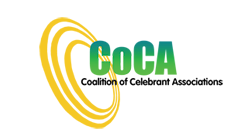Coalition of Celebrant Associations (CoCA) Suggested Approach to Assessment and Evidence Requirements for Marriage Celebrancy Units –
CHCCEL005 Establish and maintain marriage celebrancy practice
Suggested assessment activities:
• Researched and documented statistics on various aspects of family life such as marriage, divorce, domestic violence, fostering etc. that can inform a marriage celebrant about the current state of family relationships in Australia
• Researched and documented
- the impact of the 1973 changes to the Marriage Act with the introduction of the Commonwealth Civil Celebrant Program on the Australian public and existing marriage celebrants
- the impact of the 2003 changes to the celebrant program with the introduction of the Commonwealth Civil Celebrant Program on the Australian public and existing marriage celebrants
- possible impact of the 2014 changes to the celebrant program with the introduction of the Commonwealth Civil Celebrant Program on the Australian public and existing marriage celebrants
Interpreted and applied legislative requirements to create - a set of commonly asked questions that could be asked by a couple planning to marry or by a celebrant colleague
using these fourteen Sections 40-51, 112-114 of the Marriage Act as a guide,
ensuring there is at least one (1) question/ answer set from each of the fourteen (14) sections and - provide the answers to each question in user-friendly English with their referenced section, clause and paragraph numbers
Interpreted and applied marriage legislation in an open book examination that ensured the trainee was able to locate the answers to questions by using the Marriage Act, Marriage Regulations, the Code of Practice, the Marriage guidelines and related legislation
Researched and documented a report on each of the following statements
- The intent implied in Regulation 37L (3)* for the role of Commonwealth marriage celebrants is shared by the Australian community
- The intent implied in Regulation 37L (2)# for the role of Commonwealth marriage celebrants is shared by the Australian media
- The authority for deciding to marry a couple or not, is the full responsibility of the authorised marriage celebrant
including an analysis of the findings and opinions of the trainee as to how Commonwealth marriage celebrants can address issues raised by their research
* Regulation 37L (3) Recognition of significance of marriage
A marriage celebrant must recognise the social, cultural and legal significance of marriage and the marriage ceremony in the Australian community, and the importance of strong and respectful family relationships
# Regulation 37L (2) High standard of service
A marriage celebrant must maintain a high standard of service in his / her professional conduct and practice
Researched and completed a mock application for authorisation as a Commonwealth Marriage Celebrant referencing the application with the appropriate references to the Marriage Act and Regulations as well as webpages on the Attorney-General’s website (i.e. URL address of the pages) and ongoing maintenance of authorisation as a Commonwealth Marriage Celebrant
Prepared a table for each requirement of the obligations of a Commonwealth Marriage Celebrant as outlined in the Code of Practice giving
- an explanation as to why this requirement would be needed
- under what circumstances it could be difficult to meet that requirement
- how the candidate intends to meet that requirement as an independent professional marriage celebrant in the ongoing delivery of your service to the community
- what contingency plans the candidate would put in place to avoid or minimise the circumstances that could result in breaching the Code of Practice
Compared and contrasted relevant sections of the Marriage Act and the Sections 1 to 3 and 8 to 13 Marriage Guidelines to identify essential requirements and best practice for the matters and circumstances raised in the Marriage Guidelines
Researched and prepared a report on the current professional development opportunities for marriage celebrants required for ongoing authorisation including
- a list of the approved providers, their websites, contact email addresses and phone numbers
- a list of the methods of delivery (e.g. face-to-face, online) for approved ongoing professional development
- a summary of the topic/subject types of professional development
- a summary of the discounts provided by the different providers
- the responsibilities required of a Commonwealth authorised marriage celebrant in terms of professional development
- the requirements of a newly appointed marriage celebrant in relation to professional development requirements, in the situation where appointment commences after the beginning of the annual professional development period
- an assessment of the activities and topics available to match the needs of a newly authorised celebrant
- Marriage Laws
- Discrimination laws
- Statutory Declarations Act 1959
- Migration Act 1958
- Copyright Act 1968
- Privacy Act 1988
- Trade Practices Act 1974
- Australian Defamation laws
- researched this issue and prepared the script for a mock debate in which the speakers are (i) a Government minister explaining and defending the current legislation and (ii) a lobbyist presenting the counter arguments
- analysed the issues raised in this debate, imagining having been present and heard the debate in a public forum, and based on discussions of the likelihood of same sex marriage becoming possible under Australian law within the next ten (10) years as a newly authorised marriage celebrant by
- explored and summarised possible legislative changes required for marriage celebrants in Australia to marry same sex couples if this became the law, being specific about the Sections of the Marriage Act, the Regulations and the Guidelines, which would be affected if such changes occurred
- commented upon likely wording and other changes to marriage ceremonies were the celebrant to conduct a same sex couple marriage ceremony


